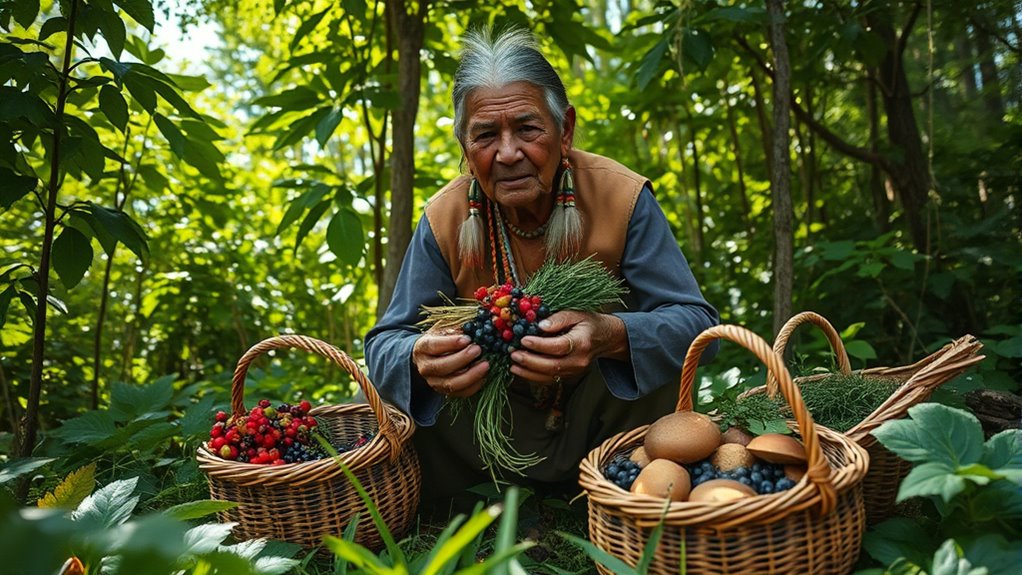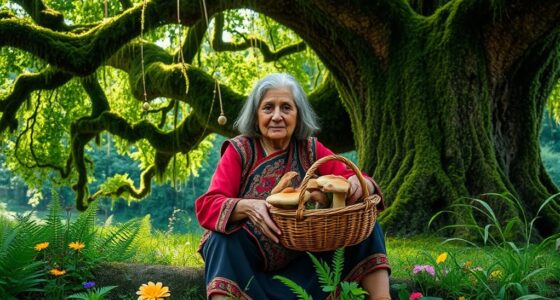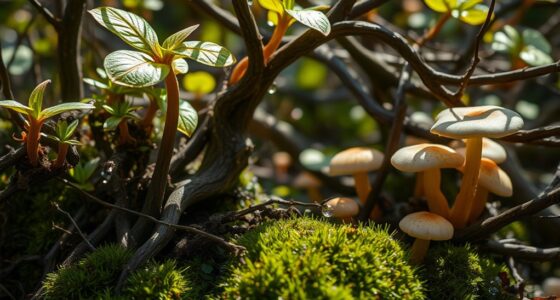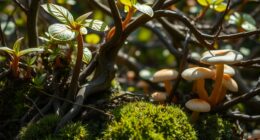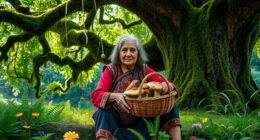Indigenous foraging stories reveal a deep spiritual bond with land, plants, and ancestors that’s been passed down for thousands of years. These traditions emphasize respectful harvesting, sustainability, and the importance of seasonal cycles. Through oral teachings and ceremonies, communities preserve their herbal knowledge, cultural practices, and connection to nature. If you explore further, you’ll discover how these timeless stories continue to shape Indigenous identities and ecological stewardship today.
Key Takeaways
- Indigenous foraging stories emphasize respect, reciprocity, and spiritual connection with nature, passing ancestral knowledge through oral traditions.
- Traditional tales highlight sustainable harvesting practices, ensuring ecological balance and resource renewal for future generations.
- Elders serve as cultural guardians, sharing stories that teach identification, proper use, and ceremonial significance of native plants.
- Foraging stories often link seasonal resource gathering with spiritual rituals, reinforcing cultural identity and community bonds.
- Indigenous narratives emphasize land stewardship, honoring plants as relatives and respecting environmental boundaries to maintain biodiversity.
The Roots of Foraging in Indigenous Heritage

The roots of foraging in Indigenous heritage run deep, shaping cultures and ways of life for thousands of years. You’re part of a long tradition where gathering wild plants and fungi wasn’t just about food—it was about survival, spirituality, and community.
Indigenous peoples harnessed ancestral knowledge to identify safe, nourishing resources, passing this wisdom through generations. Colonialism and racism, however, disrupted these connections, often forcing communities away from their lands and practices. Recognizing the importance of traditional ecological knowledge in traditional practices has helped preserve the authenticity of their cultural expressions. Moreover, the integration of Vetted foraging techniques has reinforced sustainable practices that respect the land’s cycles and biodiversity. These practices are often intertwined with Aboriginal culture, emphasizing harmony with nature and responsible stewardship. Understanding sustainable foraging methods is crucial for maintaining ecological balance and honoring Indigenous traditions.
Despite these challenges, Indigenous groups developed sophisticated and sustainable foraging methods that respect the land and its cycles. Foraging became more than sustenance; it became a spiritual act, strengthening cultural identity and maintaining a profound relationship with nature that continues today.
Cultural Significance of Seasonal Harvests
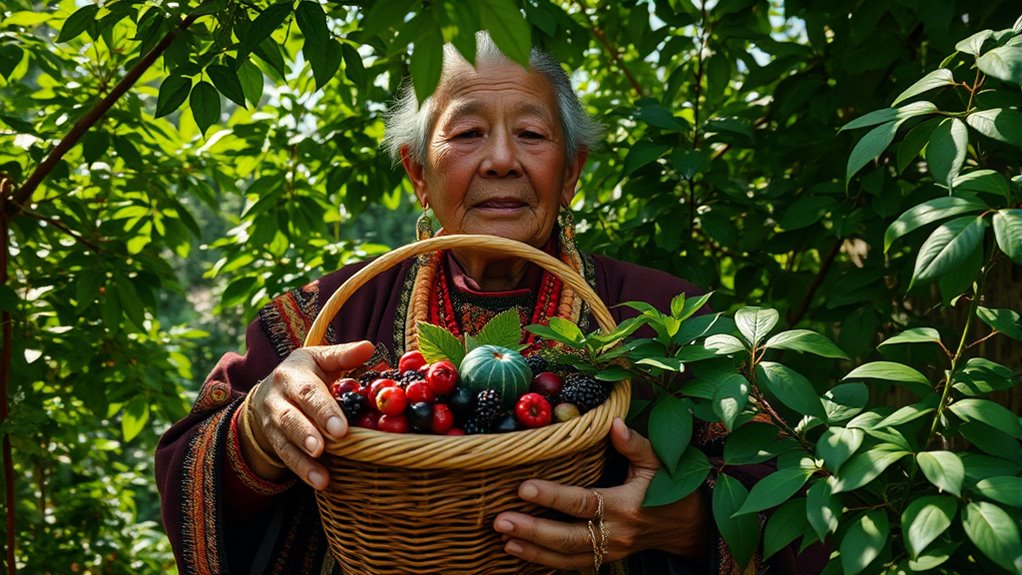
Seasonal harvests hold profound cultural and spiritual significance for Indigenous communities, shaping their identities and reinforcing bonds across generations. These practices are deeply linked to beliefs and traditions, emphasizing community cohesion and continuity. A new sentence with community engagement and the rest of the sentence.
Traditional Ecological Knowledge and Plant Identification
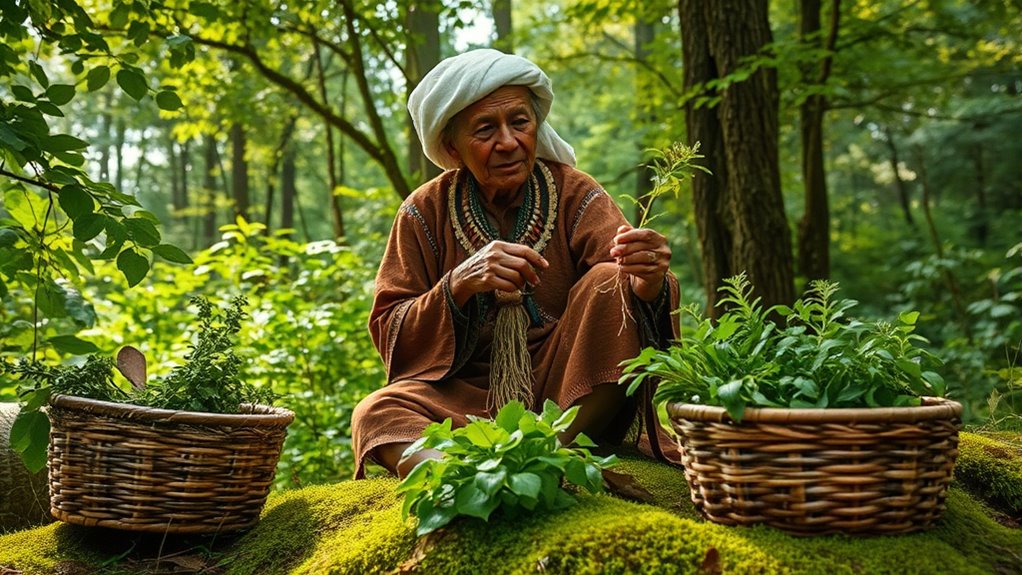
Indigenous communities have developed a deep understanding of their environments through Traditional Ecological Knowledge (TEK), a body of wisdom passed down through generations. This knowledge includes identifying plants by their diagnostic features, such as leaf scars and lenticels, which help distinguish species.
You learn to recognize useful plants like California Black Oak and Yucca baccata for food and tools, as well as medicinal plants like soaproot for shampoo and healing. TEK also emphasizes the cultural and spiritual importance of plants, shaping your relationship with nature.
This understanding allows for adaptation to local conditions, ensuring sustainable use. By observing seasonal cycles and plant behaviors, you can forage responsibly, maintaining ecosystems’ health while respecting traditional practices.
Practices of Sustainable Harvesting and Reciprocity
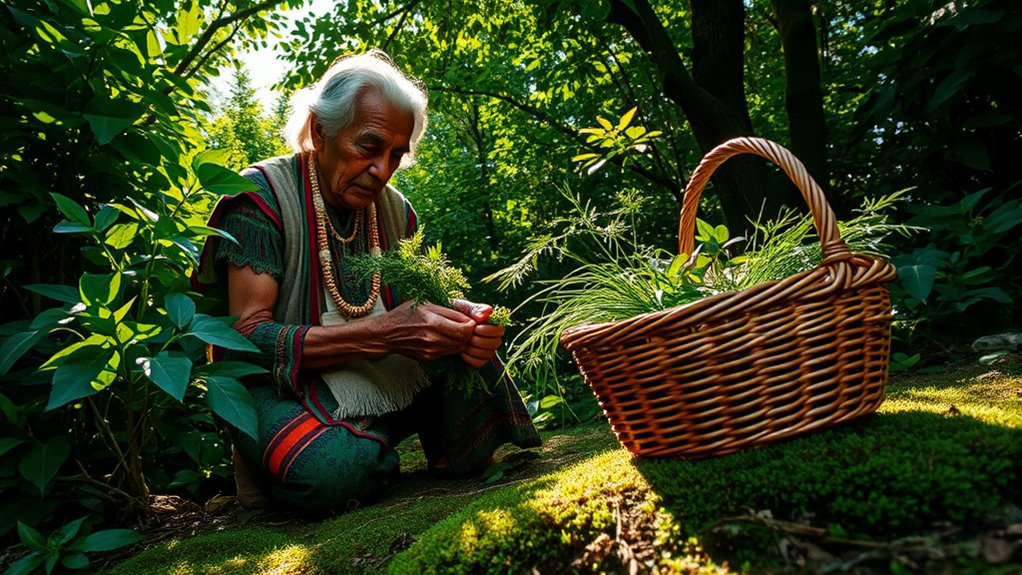
How do traditional harvesting practices guarantee that natural resources remain abundant for future generations? Indigenous communities focus on regenerative impact and ecological balance. They harvest in ways that leave ecosystems healthier, often managing lands with higher biodiversity than non-Indigenous areas. Additionally, their use of sustainable energy sources ensures minimal environmental disruption during resource collection. They also incorporate traditional ecological knowledge, which provides time-tested methods for sustainable management. These practices are complemented by a deep respect for biodiversity, which guides their stewardship and helps maintain ecological diversity. Protecting species is central—they ask permission from both landowners and Plant Nations, practicing reciprocity by giving back to nature through sustainable methods. Respect for plants as sentient beings guides their approach, with plants offering insights on how to harvest responsibly. These practices promote ecosystem resilience and long-term sustainability, emphasizing community involvement and environmental stewardship. By integrating traditional knowledge, indigenous communities adapt to climate change and ensure that resources remain available for future generations—fostering a harmonious, reciprocal relationship with the land. Their mindful harvesting techniques serve as models for sustainable resource management worldwide. Moreover, understanding the impact of climate change helps indigenous peoples modify their practices to maintain resource abundance.
Foraging as a Form of Cultural Expression and Ritual
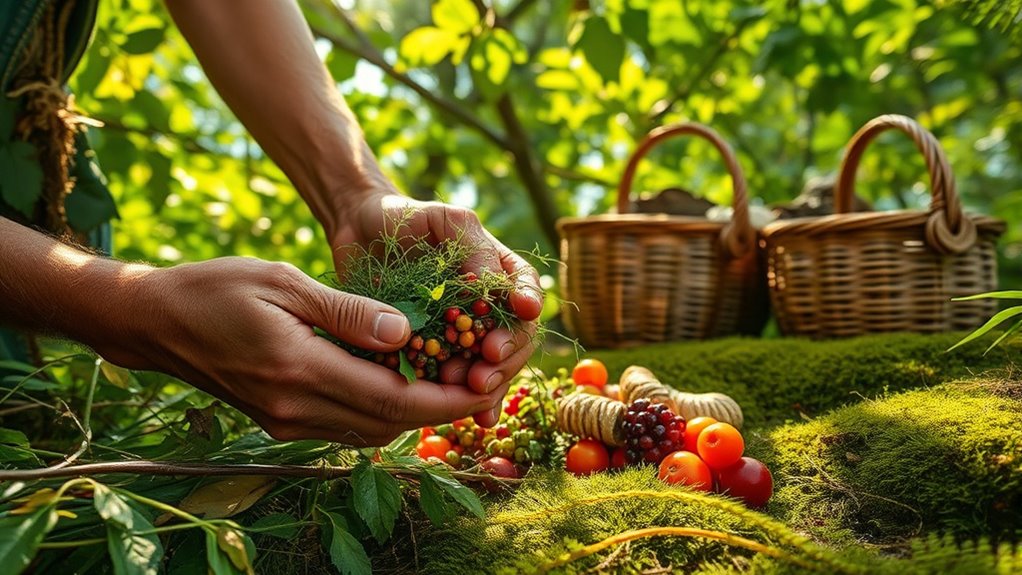
Foraging serves as a vital expression of cultural identity, linking communities to their ancestors and traditional ways of life. You participate in seasonal food rounds, gathering and processing foods cooperatively, which strengthens social bonds and keeps cultural heritage alive. Engaging in these practices fosters a deep sense of cultural continuity and respect for ancestral knowledge. Ritual foods and ceremonial feasts highlight the spiritual importance of foraging, often aligned with lunar cycles or specific seasons. These practices aren’t just about sustenance—they’re acts of respect and reverence for the land. Foraging becomes a ritual, embodying values of reciprocity and spiritual responsibility. It’s a way to honor your ancestors and maintain your community’s connection to the land. Additionally, understanding the traditional ecological knowledge behind these practices aids in sustainable harvesting and preservation of local ecosystems. Recognizing the importance of community-based conservation supports the preservation of biodiversity and cultural traditions. Through these traditions, you preserve cultural stories, reinforce shared identity, and celebrate the sacred relationship between people and nature.
Land Rights and Access Challenges for Indigenous Foragers

Despite their deep connection to the land, indigenous communities often face significant legal and practical barriers that hinder their ability to access and protect traditional foraging areas. Many lack formal recognition of land rights, as complex and costly legal processes—sometimes involving dozens of steps and multiple agencies—delay or block titles. Without official titles, they’ve limited legal options against land grabs by outsiders. Large-scale projects like infrastructure and resource extraction often proceed without their consent, displacing foragers and damaging ecosystems. Social inequalities and stereotypes weaken their political voice, making advocacy difficult and risky. Violence and intimidation further threaten land defenders, discouraging community efforts. Despite some legal victories and advocacy, ongoing challenges persist, undermining indigenous communities’ ability to sustain their foraging practices and cultural ties to the land. The international community continues to highlight these issues, emphasizing the importance of respecting indigenous land rights and supporting their efforts to preserve traditional practices. Recognizing the importance of indigenous land tenure systems can empower communities to protect their territories more effectively and resist encroachments. Additionally, the lack of formal recognition often leaves indigenous groups vulnerable to land grabbing, which is facilitated by weak enforcement of existing laws. Strengthening legal protections can help mitigate these risks and bolster community resilience. Enhancing land management strategies and legal frameworks is crucial for ensuring sustainable access and safeguarding indigenous traditions.
Passing Down Knowledge: Intergenerational Teaching and Oral Traditions
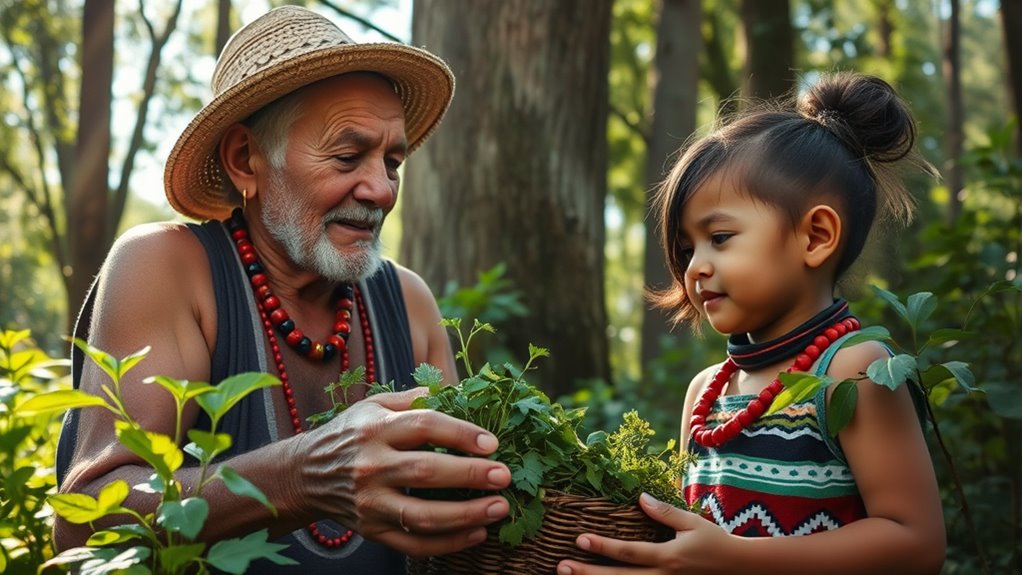
Intergenerational teaching and oral traditions play a crucial role in passing down indigenous foraging knowledge, ensuring that cultural practices and ecological understanding endure across generations. You learn to respect elders and their wisdom, recognizing their role in preserving heritage.
Through storytelling, elders convey the importance of specific plants, medicines, and ceremonies, reinforcing cultural significance. They teach unique plant classification systems tied to ecological roles and animal relationships, helping you develop vital skills for sustainable harvesting. This knowledge is often reinforced through cultural practices, which serve to deepen understanding and connection to the land. Recognizing gaslighting behaviors helps in addressing the issue and maintaining trust within oral traditions. Integrating ecological insight into these teachings ensures that environmental relationships remain strong and meaningful.
Elders serve as cultural guardians and skill transmitters, guiding you in proper protocols and land stewardship. Incorporating Cultural Intelligence into these teaching methods enhances understanding and respect for diverse cultural practices, ensuring that knowledge is transmitted effectively across generations. Additionally, emphasizing respect for tradition helps maintain the integrity of indigenous knowledge systems.
This process maintains ecological insight, cultural identity, and the sustainable practices essential for the health of both people and ecosystems.
Foraging’s Role in Food Sovereignty and Community Well-Being
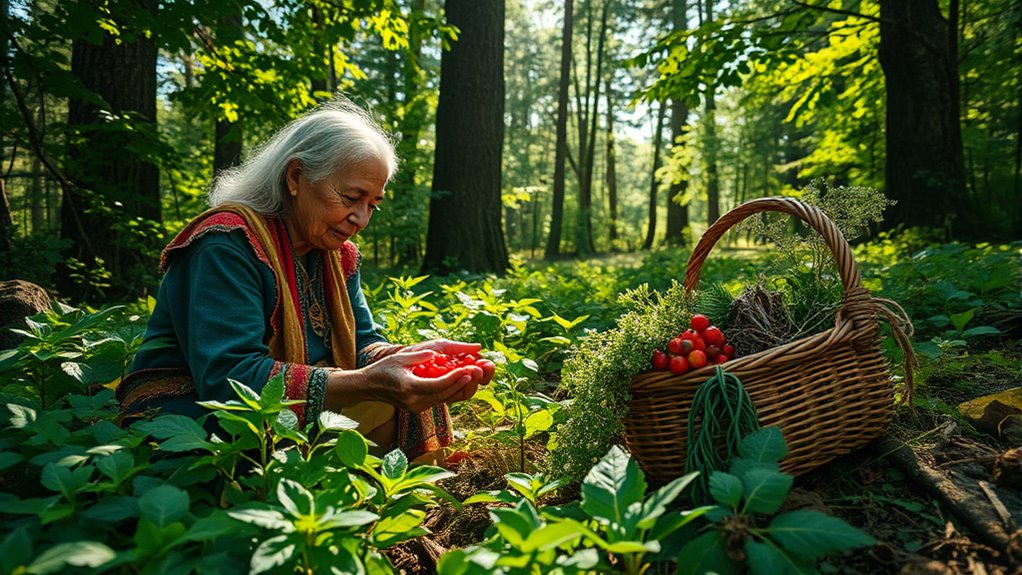
Because it connects people to their land and ancestors, foraging plays a vital role in supporting food sovereignty and community well-being among indigenous groups. It allows communities to control their food systems, access culturally significant foods, and strengthen cultural identity. It also fosters cultural resilience by maintaining traditional practices and knowledge. Foraging practices are sustainable, promoting ecological health and biodiversity conservation while ensuring resources are used responsibly. Engaging in foraging fosters social bonds, encourages cooperation, and reinforces traditional knowledge passed down through generations. It also offers mental and physical health benefits, reducing stress and providing nutrient-rich foods. Additionally, understanding local foraging areas and respecting environmental boundaries helps maintain ecological balance. Utilizing traditional ecological knowledge enhances sustainable harvesting methods and supports the resilience of indigenous food systems. By relying on local foraged resources, communities gain economic independence and resilience against external market fluctuations.
Modern Movements and the Preservation of Foraging Traditions
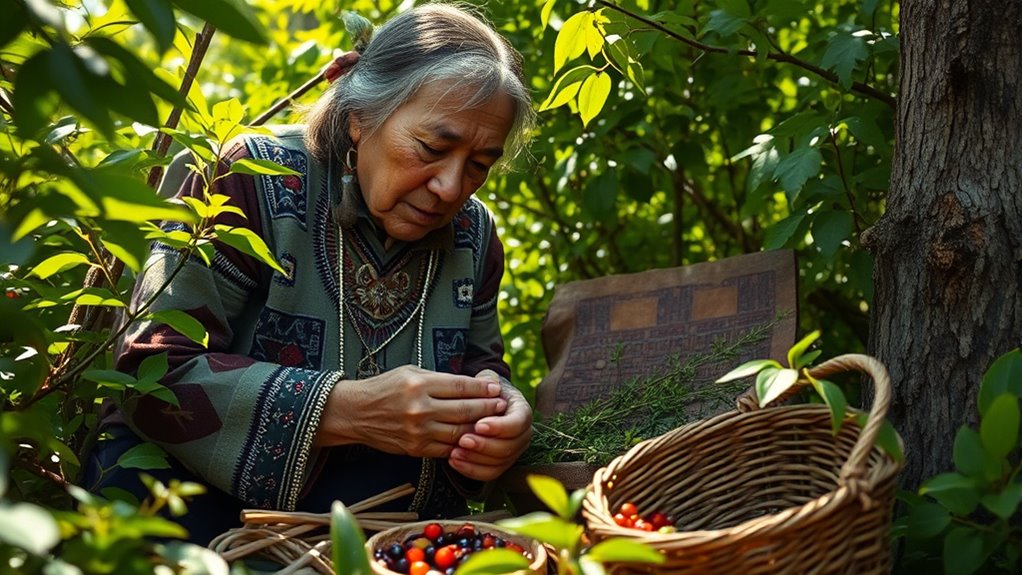
Modern movements to preserve foraging traditions face significant challenges as legal restrictions and land access barriers limit Indigenous communities’ ability to practice their cultural harvesting methods. Laws and conservation policies often block access to ancestral lands, causing cultural erosion and the loss of crucial knowledge.
Conservation efforts sometimes misinterpret Indigenous practices as harmful, overlooking their sustainability and ecological contributions. Despite these hurdles, Indigenous communities are reclaiming their foraging heritage, challenging stereotypes that associate foraging solely with non-Indigenous groups.
Indigenous communities reclaim foraging heritage, challenging stereotypes and highlighting sustainable ecological practices.
Supported by organizations promoting food sovereignty, they work to strengthen cultural ties and sustainable practices. Education initiatives led by Indigenous groups focus on respectful foraging, learning from ancestors, and raising awareness about these barriers.
These efforts aim to preserve traditions and ensure Indigenous voices remain central in land and resource management.
Celebrating Indigenous Wisdom Through Food and Nature

Indigenous communities celebrate their deep connection to land and nature by integrating traditional knowledge into their food systems. You see, these systems blend food production with natural cycles, emphasizing community involvement and sustainable resource management.
Practices like rotational agriculture, used by groups like the Maya and Karen, maintain ecosystem health and honor ancestral wisdom. Respect and reciprocity with nature guide hunting, gathering, and farming, reflecting spiritual beliefs that view land as sacred.
Foraging isn’t just about gathering food; it’s a cultural practice rooted in recognizing plants as relatives. These traditions highlight an intrinsic relationship with nature, balancing human needs with ecological preservation.
When indigenous knowledge is respected and scaled, it can foster sustainable food systems that benefit both people and the planet.
Frequently Asked Questions
How Do Indigenous Foragers Identify and Differentiate Edible Versus Poisonous Plants?
You identify and differentiate edible from poisonous plants by relying on traditional knowledge passed down through generations. Pay attention to plant names, ecological clues, and cultural stories that highlight their uses.
Observe the plant’s characteristics and growth patterns, and consult guides or experts. Respect nature by harvesting sustainably, always verifying your identification.
Your community’s teachings and experience are essential tools for safe, respectful foraging practices.
What Legal Rights Do Indigenous Communities Have Regarding Land Access for Foraging?
You might wonder about Indigenous communities’ land access rights for foraging. Typically, they face limited legal rights due to land rights issues and restrictive regulations.
Often, they need permits or permission to forage on public or private lands. Despite these challenges, many fight for greater autonomy, aiming to reclaim traditional land use.
Recognizing their rights is essential to support cultural preservation and sustainable foraging practices.
How Is Traditional Ecological Knowledge Transmitted Across Generations?
You learn that traditional ecological knowledge is passed down through storytelling, oral traditions, and active involvement of elders.
As you connect with elders, they share experiences, practices, and land relationships that shape your understanding.
Intergenerational collaboration guarantees this knowledge stays alive, helping your community adapt to environmental changes and maintain cultural practices.
Respect for land, combined with shared stories, keeps your ecological wisdom vibrant and relevant across generations.
In What Ways Do Modern Laws Impact Indigenous Foraging Practices?
Modern laws profoundly impact your indigenous foraging practices by restricting access to traditional lands and resources. You might face fines or penalties if caught collecting wild foods in protected areas.
These laws often disconnect you from cultural traditions, leading to the loss of knowledge passed down through generations. While meant for conservation, they can also marginalize your community, making it harder to sustain your cultural identity and traditional practices.
How Can Non-Indigenous People Support Indigenous Foraging and Land Rights?
You can support Indigenous foraging and land rights by respecting their cultural practices, engaging with their communities, and learning about their history. Don’t just take from the land—donate, volunteer, and advocate for their land rights and sovereignty.
Always verify information from multiple sources, prioritize sustainable harvesting, and acknowledge the importance of their spiritual connections to the land. Your actions help preserve their traditions and promote environmental justice.
Conclusion
By embracing indigenous foraging stories, you connect with centuries of ecological wisdom and cultural resilience. Did you know that over 80% of the world’s food crops originate from indigenous knowledge? When you honor these traditions, you help preserve essential ecosystems and strengthen community bonds. Your respect for these practices supports food sovereignty and the ongoing celebration of indigenous wisdom, ensuring that future generations can continue to learn from and thrive with nature’s abundance.

